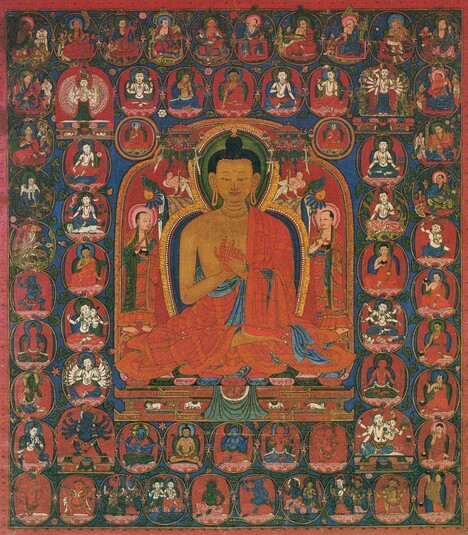
Item: Shakyamuni Buddha
| Origin Location | Tibet |
|---|---|
| Date Range | 1400 - 1499 |
| Lineages | Buddhist |
| Material | Ground Mineral Pigment on Cotton |
| Collection | Private |
Classification: Person
Shakyamuni Buddha (Tibetan: sha kya tu pa, sang gye. English: the Enlightened One, Sage of the Shakya Clan), founder of Buddhism. (See detail images of the surrounding figures).
Sanskrit: Buddha Shakyamuni Tibetan: Sang gye sha kya tu pa
Tibetan: Sang gye sha kya tu pa
Formal in appearance, the Buddha gazes forward with partially closed eyes and the blue-black hair on the head is piled in a tuft on top with a single gold ornament adorning the crown. Between the eyebrows is a white dot (urna) and adorning the neck are three curved horizontal lines. The earlobes are long and pierced. With the right arm bare, both hands perform the gesture of teaching at the heart with the 'wheel-turning' mudra. Across the left shoulder is a saffron coloured patchwork robe. A similar lower garment is tied at the waist with a cloth belt. The legs are folded in vajra posture. Standing at the right and left sides are the two principal disciples of the Buddha, Shariputra and Maudgalyayana. Above to the right and left are two small rainbow spheres containing two Tibetan teachers wearing monastic robes.
"Born in the Shakya race through skillful means and compassion; destroying the army of Mara who was unable to be destroyed by others; with a body radiant like a mountain of gold. Homage to you, King of Shakya." (Sakya liturgical verse).
Inner Register: At the top center is Shakyamuni Buddha flanked on the sides by what appears to be Maitreya on the left and Lokeshvara on the right. Chaturbhuja Lokeshvara is further on the left and another two-armed form of Lokeshvara on the right. The majority of figures in the inner register are forms of Avalokiteshvara. The four forms in the four corners either seated or standing on thrones are from the top left moving clockwise: Eleven-faced Lokeshvara, Amoghapasha, Hala Hala Lokeshvara and Lokeshvara Wrathful Lord of the World.
On the left side of the inner register are Simhanada in simple form, Simhanada, a pratyekabuddha, Padmanarteshvara with consort and Padmanarteshvara/Padmajala with eighteen arms. On the right side are two white forms of Lokeshvara, a pratyekabuddha, Hari Hari Hari Bhavan Lokeshvara and Trailokya Vashamkara Lokeshvara. At the bottom center of the inner register is blue Vajrapani, with Nilakanta Lokeshvara on the left and a blue figure alongside. On the right is red Lokeshvara with a red Hayagriva alongside.
Outer Register: In the top register and descending to the left and right and finishing at the bottom center are the Sixteen Great Arhats. Note that there is no image of the Chinese patron - Hvashang.
Descending further on the left is Blue Achala, Shri Vajradharma Lokeshvara, a green kneeling figure, a white kneeling figure, Hayagriva, Charchika, two of the four Guardian Kings, two of the Four Hindu Gods and Green Vajravidarana at the bottom center.
Descending on the right are White Achala, five monastic figures, the goddess Bhrikuti, two of the Four Guardian Kings and two of the Four Hindu Gods.
Jeff Watt 3-2012
Publication: Tibet, Tradition & Change
Thematic Sets
Details of 43763, Shakyamuni Buddha
Arhat: Dharmata (Early Art)
Publication: Tibet, Tradition & Change (Painting)
Shakyamuni Buddha & the Sixteen Elders (Single Composition)
Shakyamuni Buddha: Various Iconographic Subjects
Painting Style: Gyantse Scroll Paintings
Buddhist Deity: Lokeshvara, Nilakanta (Blue Necked)
Subject: Torana, Shakyamuni Buddha (Early Animal Depictions)
Shakyamuni Buddha: Early Paintings
Shakyamuni Buddha, 释迦牟尼佛:, ཤཱཀྱ་ཐུབ་པ། Painting (Masterworks)
Buddhist Deity: Avalokiteshvara (Compendium Paintings)
Collection: Private 1
